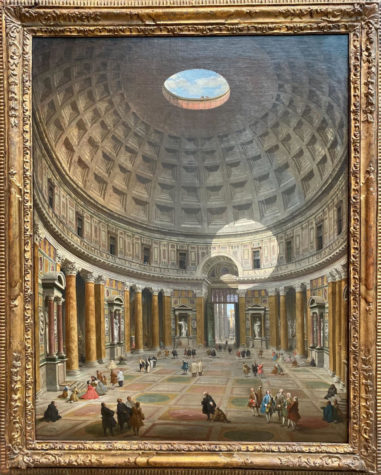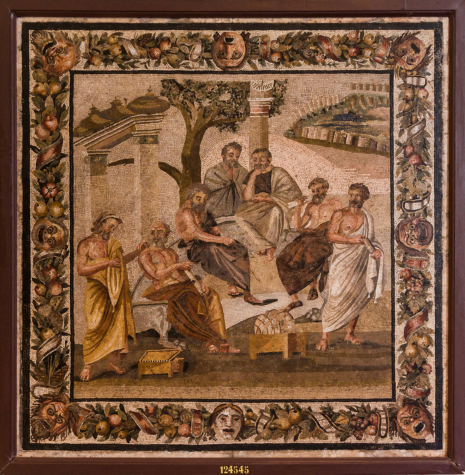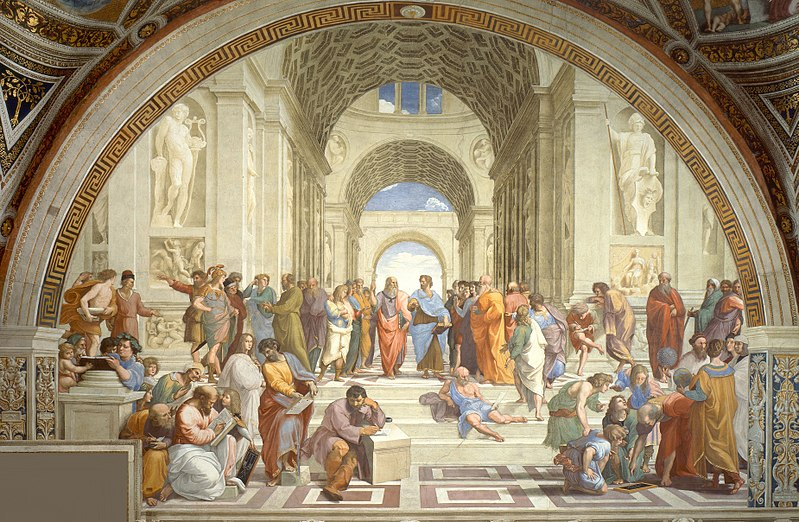Raphael Merits an A+ at The School of Athens
As international debate is sparked over the science of vaccines, Raphael reminds us where this way of thought stems from in his fresco, ‘The School of Athens.’
Painted in 1510, the fresco of ‘The School of Athens’ covers one of four walls in the Apostolic Palace library in the Vatican.
A classroom full of illustrious intellectuals comes to a hush as its esteemed instructor enters. The teacher is thin and dons a hat of fraying bristles. Star pupils Aristotle and Plato unpack their parchment and quills, preparing for yet another pivotal lesson at The School of Athens.
Though a paintbrush is not the most conventional symbol of a science teacher, Raphael breaks tradition in his famous fresco, The School of Athens. The artwork combines fields that seemingly fall under opposite ends on the spectrum of subjectivity: art and science. “In America, we’re often taught to regard the humanities and sciences as polar opposites,” said Katia Anastas ’23. “In the real world, there’s much more of an overlap.”
Such an intersection fits the fresco’s location like a glove, sitting just above eye level in the Apostolic Palace Library at the heart of Vatican City. Libraries are omniscient, flooding the minds of their users with a consistent stream of knowledge regarding the human condition. Raphael’s work is a visual representation of such a stream, as scholarship is ubiquitous within it.
The fresco’s placement was carefully calculated within all four of the library’s walls, each representing a different branch of knowledge. Raphael painted metaphors for theology, justice, literature, and as found in The School of Athens, philosophy. Though he incorporates allusions to religion in the aforementioned artwork, Raphael chooses to illustrate this subject more prominently in his lesser known piece, The Disputation of the Holy Sacrament.
This otherworldly fresco sits on the wall directly opposite from The School of Athens. Theology and philosophy are positioned as equals, yet in direct opposition. Finished in 1510, the humanist, academic facet of the painting is reflective of societal evolution throughout the European Renaissance, during which The School of Athens was painted. Europe’s “rebirth” was a striking rebound from the Bubonic plague, which was ravaging Europe with death, despair, and destitution.
Artistic trends during the Middle Ages quite literally illustrated this widespread anguish through their almost exclusively religious nature. As social and economic upheaval persisted, religion was a burning beacon of hope which lit the fire of piety.
These religious flames were lessened during the Renaissance, as Europe experienced a colossal shift towards secularism and sagacity. Society took on a classical spirit, trading sermons for science and gospel for Galileo. Raphael references this return to Ancient Greek and Roman thinking in his depictions of Plato (left) and his most prominent student, Aristotle (right). The two figures are a symbol of a larger cultural phenomenon: the juxtaposition of philosophy and theology.
Plato is representative of society’s religious facet, evident in his upward pointing motion. By signaling towards a higher power, he indicates his philosophical dissection of divinity. He is depicted with his book Timaeus in hand, as if to carry the weight of his wisdom. The book details Plato’s hypotheses on how the world came to be, arguing that the world around him was a fraction of reality, and the core of knowledge lies within the spiritual realm.
Alongside Plato is the younger yet equally astute Aristotle. He believed that philosophy revolves around the tangible, observable universe, a phenomenon heavily emphasized in his book Nicomachean Ethics, which he is pictured holding. This opinion is revealed through his body language, as Raphael paints Aristotle as pointing downwards, towards the ground below him. In doing so, Aristotle motions to the “here and now.”
Both Aristotle and his teacher (Plato) are highlighted in the painting using a technique called linear perspective. The artistic strategy uses a single vanishing point to create the illusion of depth on a flat surface. Though The School of Athens was painted directly onto a wall, it resembles a vast pavilion. The vanishing point, or the point to which all parallel lines lead, is the painting of Plato and Aristotle, rendering the contrast between spirituality and science the fresco’s focal point.
The two philosophers draw a line down the center of the painting; it is not visible to the human eye, but its effect is powerful. Raphael uses Plato and Aristotle to separate the other figures into two groups based on their academic beliefs. Those on the right, such as Euclid, were more closely aligned with the latter thinker, focused on the physical and concrete.
Those on the left, including Pythagoras, agreed with the former theorist. Both Plato and Pythagoras believed in a universe that transcended reality, delving into a figurative world. Though there can never be a clear division between two elements of thought, Raphael distinguishes differing approaches to world views into Platonian and Aristotelian values.

The use of this symmetrical style is an ode to the laws of mathematics in itself. Current Physics teacher Mr. Seoh, who has taught Art History in previous years at Bronx Science, described the incorporation of vanishing points as “mathematically rigorous.” Both Raphael and his lessons embody the intersection of art and science pervasive throughout The School of Athens, challenging art students to “come up with the rules to construct 3D spaces.”
Though less emphasized than the vanishing point of such “space,” the myriad of other figures within the painting are equally paramount to the holistic work. Writing in his notebook in the painting’s bottom left corner, for one, is Pythagoras.
While the monotonous Pythagorean theorem is taught in classrooms, Pythagoras’ “harmony of the spheres” theory remains largely unlauded. Pythagoras believed that planets released musical notes every time they moved, creating a celestial melody.
He tied such spiritual hypotheses into his mathematical studies, asserting that math was the governing law of the cosmos, and therefore must have a relationship to God. Mr. Seoh does not agree with this similarity. “Science always has to be rooted in the natural world,” Seoh said. “Art doesn’t have to be rooted in anything except human experience.”
To the far right of Pythagoras is Raphael himself. He dons a black hat, and paints himself among a huddle of Iranian prophet Zaroaster, Egyptian astronomer Ptolemy, and Greek painter Protogenes. Unlike every other intellectual in The School of Athens, Raphael’s gaze is directed towards onlookers. He is not engaged in educational conversation, but rather, a staring contest with admirers of his work.
Raphael’s attention to detail is further evident in his subtle use of symbolism. The statues in the fresco’s background are not immediately noticeable, but heavily contribute to the fresco’s allusions to Ancient Greek and Roman culture. The leftmost statue represents Apollo, the Greek god of archery, light, and music. He holds a string instrument called a lyre in his left hand, distinguishing him from the other statue of Greek goddess Athena.
Though Roman theology refers to the deity as Minerva, both cultures can agree upon her representation of wisdom. She was widely regarded as the epitome of scholarship, meriting the naming of a Greek city (Athens) after her. Athena’s representation of knowledge is a clear cut piece from the puzzle that is The School of Athens, creating a cohesive image of humanist discovery.
Raphael incorporates more specific symbols in his fresco by using seemingly insignificant objects to refer to philosophical concepts. His depiction of Greek philosopher Heraclitus, front and center, was added after the original painting was complete. This last minute addition proves to be invaluable when examining the significance of Heraclitus’s inkwell. He is hunched over a block of marble, and pauses mid-thought, quill in hand. His writing has not yet dried, captured in a glimpse of time that is all but indelible.
The inkwell is the source from which Heraclitus’s stream of consciousness flows, symbolic of the infinite ebb and flow of time. Raphael paints an image that encapsulates a single moment, and thus a mere fraction of this phenomenon, but acknowledges Hercalitus’s philosophy on time through small visual cues.
Much as the addition of Heraclitus was a later change, The School of Athens was not the fresco’s original title. Rather, Raphael had inscribed the phrase “Causarum Cognitio,” meaning “Knowledge of Causes,” directly onto the wall above it. The original title is, arguably, more apt, as it is culturally broader. When naming a painting in which only one of three figures are Athenian, it is imperative to consider the course of human studies outside of Athens.
Raphael’s “models” were far from Athenian as well. Having been born over a millennium after most scholars depicted in his work, Raphael looked elsewhere for a visual representation of ancient archetypes. He turned to Leonardo da Vinci, for example, to model his depiction of Plato. Similarly, Raphael modeled Aristotle after the Italian sculptor Giuliano da Sangallo, Heraclitus after Michelangelo, and Euclid as Italian architect Donato Bramante.

One work that was not challenged with such adversity is Plato’s Academy Mosaic, which was created for the villa of T. Siminius Stephanus in Pompeii, around 100 BC to 79 AD by unknown artisans. Currently, it resides in the National Archaeological Museum of Naples. The work contains a plethora of stylistic similarities to Raphael’s fresco; the mosaic’s style resembles that of The School of Athens greatly. In both pieces, a group of well known scientists discuss thought provoking concepts amidst an architecturally detailed background. Though composed of tile fragments, Plato’s Academy Mosaic pays a level of attention to detail akin to Raphael in his fresco.
Despite the likeness of the two works, the ages during which they were fabricated differs greatly. The School of Athens was finished in roughly 1510, while Plato’s Academy Mosaic dates back to before 79 AD. Their educational implications demonstrate the timelessness of philosophy, as it is prevalent in art from the first century, the sixteenth, and even still in 1996.
During this year, Bill Viola created The Crossing, depicting two sects of thought: Eastern and Western ideas. The Crossing is a video, projected onto a larger-than-life screen in the center of a vast room for ten minutes and fifty seven seconds. Viola splits the film into two frames of the same man, inching slowly towards the camera. On the left frame, he appears to be lit on fire, slowly engulfed by the scintillating orange flames. On the right, he is doused in a heavy, silver stream of water.
By incorporating various natural elements into his work, Viola questions how humanity came to understand and interact with the world. Such inquiry is inspired by theology, as The Crossing contrasts the philosophies of Hinduism, Buddhism, and Catholicism. The ring of fire, for example, calls upon Hindu God Nataraja, or “Lord of the Dance,” depicted in ancient artworks as dancing amidst a band of flames.
As art evolves from tiles and cement, to oil paint, to video projectors, Plato and Aristotle hear the droning of class bells which mark the end of each period. They begin to repack their quills, as they are now finished with their lesson at The School of Athens.
“In America, we’re often taught to regard the humanities and sciences as polar opposites,” said Katia Anastas ’23. “In the real world, there’s much more of an overlap.”
Sela Emery is a Copy Chief for 'The Science Survey.' She focuses on art history, covering relevant art pieces and exhibitions with each issue. In addition...

